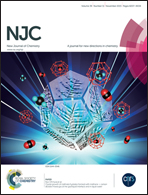Synthesis of BiOI/Bi4O5I2/Bi2O2CO3 p–n–p heterojunctions with superior photocatalytic activities†
Abstract
A one-dimensional (1D) BiOI/Bi4O5I2/Bi2O2CO3 p–n–p heterojunction photocatalyst was synthesized by a low-temperature solution method using Bi2O3 nanorods as sacrificial templates. The formation mechanism of BiOI/Bi4O5I2/Bi2O2CO3 heterostructure was discussed in detail according to the results of IR, XPS, TEM, SEM mapping, XRD and SEM. Compared with pure BiOI, Bi2O2CO3 and Bi4O5I2, this ternary p–n–p heterojunction exhibited superior photodegradation efficiency of rhodamine B (100%) and methylene blue (97%) in 45 min under solar light irradiation, which was about 40, 25 and 10 times of pure BiOI, Bi2O2CO3 and Bi4O5I2, respectively. This enhanced photocatalytic performance was ascribed to the high separation rate of photo-generated carriers in the internal electric field due to the formation of p–n–p junctions and a relatively large BET surface area (36.29 g m−2). More importantly, 1D heterostructure is beneficial for the transport of photo-generated electron–hole pairs and further improves the rate of photocatalytic reaction. Radical scavenger experiments revealed that the photo-generated holes were primarily active species in the photocatalytic system. This work would offer a new insight into the design and fabrication of ternary p–n–p junction structures for photocatalytic applications.


 Please wait while we load your content...
Please wait while we load your content...